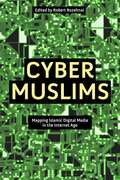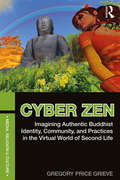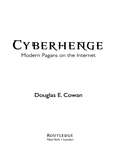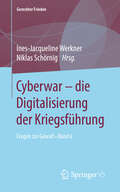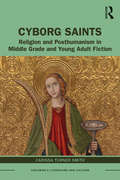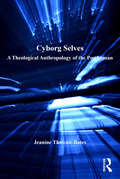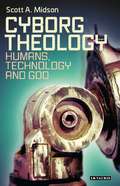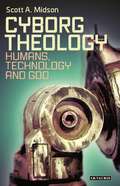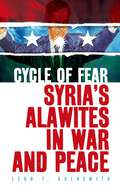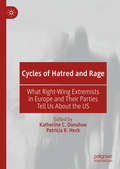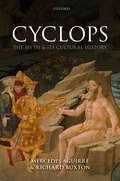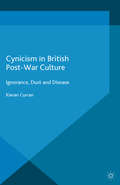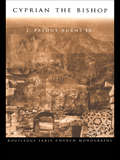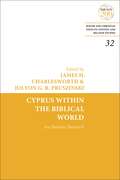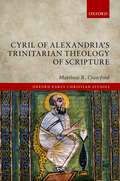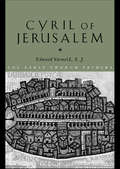- Table View
- List View
Cyber Muslims: Mapping Islamic Digital Media in the Internet Age
Through an array of detailed case studies, this book explores the vibrant digital expressions of diverse groups of Muslim cybernauts: religious clerics and Sufis, feminists and fashionistas, artists and activists, hajj pilgrims and social media influencers. These stories span a vast cultural and geographic landscape-from Indonesia, Iran, and the Arab Middle East to North America. These granular case studies contextualize cyber Islam within broader social trends: racism and Islamophobia, gender dynamics, celebrity culture, identity politics, and the shifting terrain of contemporary religious piety and practice. The book's authors examine an expansive range of digital multimedia technologies as primary “texts.” These include websites, podcasts, blogs, Twitter, Facebook, Instagram, YouTube channels, online magazines and discussion forums, and religious apps. The contributors also draw on a range of methodological and theoretical models from multiple academic disciplines, including communication and media studies, anthropology, history, global studies, religious studies, and Islamic studies.
Cyber Zen: Imagining Authentic Buddhist Identity, Community, and Practices in the Virtual World of Second Life (Media, Religion and Culture)
by Gregory Price GrieveCyber Zen ethnographically explores Buddhist practices in the online virtual world of Second Life. Does typing at a keyboard and moving avatars around the screen, however, count as real Buddhism? If authentic practices must mimic the actual world, then Second Life Buddhism does not. In fact, a critical investigation reveals that online Buddhist practices have at best only a family resemblance to canonical Asian traditions and owe much of their methods to the late twentieth-century field of cybernetics. If, however, they are judged existentially, by how they enable users to respond to the suffering generated by living in a highly mediated consumer society, then Second Life Buddhism consists of authentic spiritual practices. Cyber Zen explores how Second Life Buddhist enthusiasts form communities, identities, locations, and practices that are both products of and authentic responses to contemporary Network Consumer Society. Gregory Price Grieve illustrates that to some extent all religion has always been virtual and gives a glimpse of possible future alternative forms of religion.
Cyber Zen: Imagining Authentic Buddhist Identity, Community, and Practices in the Virtual World of Second Life (Media, Religion and Culture)
by Gregory Price GrieveCyber Zen ethnographically explores Buddhist practices in the online virtual world of Second Life. Does typing at a keyboard and moving avatars around the screen, however, count as real Buddhism? If authentic practices must mimic the actual world, then Second Life Buddhism does not. In fact, a critical investigation reveals that online Buddhist practices have at best only a family resemblance to canonical Asian traditions and owe much of their methods to the late twentieth-century field of cybernetics. If, however, they are judged existentially, by how they enable users to respond to the suffering generated by living in a highly mediated consumer society, then Second Life Buddhism consists of authentic spiritual practices. Cyber Zen explores how Second Life Buddhist enthusiasts form communities, identities, locations, and practices that are both products of and authentic responses to contemporary Network Consumer Society. Gregory Price Grieve illustrates that to some extent all religion has always been virtual and gives a glimpse of possible future alternative forms of religion.
Cyberhenge: Modern Pagans on the Internet
by Douglas E. CowanCyberhenge examines the use of Internet technology in shaping religious traditions and rituals. Cowan asks how and why Neopaganism has embraced the Internet in such an innovative and imaginative way.
Cyberhenge: Modern Pagans on the Internet
by Douglas E. CowanCyberhenge examines the use of Internet technology in shaping religious traditions and rituals. Cowan asks how and why Neopaganism has embraced the Internet in such an innovative and imaginative way.
Cyberwar – die Digitalisierung der Kriegsführung: Fragen zur Gewalt • Band 6 (Gerechter Frieden)
Die Digitalisierung der Kriegsführung fordert klassische und etablierte Sicherheitsvorkehrungen in einem bislang nicht bekannten Maße heraus: Das reicht von der zunehmenden Verschmelzung militärischer und ziviler Räume über ihre hohe Wirkasymmetrie bis hin zum Problem der Attribution. Dabei ist das Phänomen des Cyberwar nicht unumstritten. Ist er – so eine zentrale Frage dieses Bandes – mit konventionellen Vorstellungen von Gewalt, Krieg und Kriegsführung kompatibel? Die Autorinnen und Autoren reflektieren den Begriff des Cyberwar und seine Implikationen aus technologischer, friedenspolitischer, völkerrechtlicher, rüstungspolitischer und theologischer Perspektive.
Cyborg Saints: Religion and Posthumanism in Middle Grade and Young Adult Fiction (Children's Literature and Culture)
by Carissa Turner SmithSaints are currently undergoing a resurrection in middle grade and young adult fiction, as recent prominent novels by Socorro Acioli, Julie Berry, Adam Gidwitz, Rachel Hartman, Merrie Haskell, Gene Luen Yang, and others demonstrate. Cyborg Saints: Religion and Posthumanism in Middle Grade and Young Adult Fiction makes the radical claim that these holy medieval figures are actually the new cyborgs in that they dethrone the autonomous subject of humanist modernity. While young people navigate political and personal forces, as well as technologies, that threaten to fragment and thingify them, saints show that agency is still possible outside of the humanist construct of subjectivity. The saints of these neomedievalist novels, through living a life vulnerable to the other, attain a distributed agency that accomplishes miracles through bodies and places and things (relics, icons, pilgrimage sites, and ultimately the hagiographic text and its reader) spread across time. Cyborg Saints analyzes MG and YA fiction through the triple lens of posthumanism, neomedievalism, and postsecularism. Cyborg Saints charts new ground in joining religion and posthumanism to represent the creativity and diversity of young people’s fiction.
Cyborg Saints: Religion and Posthumanism in Middle Grade and Young Adult Fiction (Children's Literature and Culture)
by Carissa Turner SmithSaints are currently undergoing a resurrection in middle grade and young adult fiction, as recent prominent novels by Socorro Acioli, Julie Berry, Adam Gidwitz, Rachel Hartman, Merrie Haskell, Gene Luen Yang, and others demonstrate. Cyborg Saints: Religion and Posthumanism in Middle Grade and Young Adult Fiction makes the radical claim that these holy medieval figures are actually the new cyborgs in that they dethrone the autonomous subject of humanist modernity. While young people navigate political and personal forces, as well as technologies, that threaten to fragment and thingify them, saints show that agency is still possible outside of the humanist construct of subjectivity. The saints of these neomedievalist novels, through living a life vulnerable to the other, attain a distributed agency that accomplishes miracles through bodies and places and things (relics, icons, pilgrimage sites, and ultimately the hagiographic text and its reader) spread across time. Cyborg Saints analyzes MG and YA fiction through the triple lens of posthumanism, neomedievalism, and postsecularism. Cyborg Saints charts new ground in joining religion and posthumanism to represent the creativity and diversity of young people’s fiction.
Cyborg Selves: A Theological Anthropology of the Posthuman (Routledge Science and Religion Series)
by Jeanine Thweatt-BatesWhat is the 'posthuman'? Is becoming posthuman inevitable-something which will happen to us, or something we will do to ourselves? Why do some long for it, while others fearfully reject it? These questions underscore the fact that the posthuman is a name for the unknown future, and therefore, not a single idea but a jumble of competing visions - some of which may be exciting, some of which may be frightening, and which is which depends on who you are, and what you desire to be. This book aims to clarify current theological and philosophical dialogue on the posthuman by arguing that theologians must pay attention to which form of the posthuman they are engaging, and to demonstrate that a 'posthuman theology' is not only possible, but desirable, when the vision of the posthuman is one which coincides with a theological vision of the human.
Cyborg Selves: A Theological Anthropology of the Posthuman (Routledge Science and Religion Series)
by Jeanine Thweatt-BatesWhat is the 'posthuman'? Is becoming posthuman inevitable-something which will happen to us, or something we will do to ourselves? Why do some long for it, while others fearfully reject it? These questions underscore the fact that the posthuman is a name for the unknown future, and therefore, not a single idea but a jumble of competing visions - some of which may be exciting, some of which may be frightening, and which is which depends on who you are, and what you desire to be. This book aims to clarify current theological and philosophical dialogue on the posthuman by arguing that theologians must pay attention to which form of the posthuman they are engaging, and to demonstrate that a 'posthuman theology' is not only possible, but desirable, when the vision of the posthuman is one which coincides with a theological vision of the human.
Cyborg Theology: Humans, Technology and God
by Scott A. MidsonIn particular, Donna Haraway argued in her famous 1991 'Cyborg Manifesto' that people, since they are so often now detached and separated from nature, have themselves evolved into cyborgs. This striking idea has had considerable influence within critical theory, cultural studies and even science fiction (where it has surfaced, for example, in the Terminator films and in the Borg of the Star Trek franchise). But it is a notion that has had much less currency in theology. In his innovative new book, Scott Midson boldly argues that the deeper nuances of Haraway's and the cyborg idea can similarly rejuvenate theology, mythology and anthropology. Challenging the damaging anthropocentrism directed towards nature and the non-human in our society, the author reveals - through an imaginative reading of the myth of Eden - how it is now possible for humanity to be at one with the natural world even as it vigorously pursues novel, 'post-human', technologies.
Cyborg Theology: Humans, Technology and God (Library of Modern Religion)
by Scott A. MidsonThe concept of the cyborg, or cybernetic organism, has led to notably creative explorations of the ambiguous relationship between human beings and technology. In particular, Donna Haraway argued in her famous 1991 'Cyborg Manifesto' that people, since they are so often now detached and separated from nature, have themselves evolved into cyborgs. This striking idea has had considerable influence within critical theory, cultural studies and even science fiction (where it has surfaced, for example, in the Terminator films and in the Borg of the Star Trek franchise). But it is a notion that has had much less currency in theology. In his innovative new book, Scott Midson boldly argues that the deeper nuances of Haraway's and the cyborg idea can similarly rejuvenate theology, mythology and anthropology. Challenging the damaging anthropocentrism directed towards nature and the non-human in our society, the author reveals – through an imaginative reading of the myth of Eden – how it is now possible for humanity to be at one with the natural world even as it vigorously pursues novel, 'post-human', technologies.
Cycle of Fear: Syria's Alawites in War and Peace
by Leon GoldsmithIn early 2011 an elderly Alawite shaykh lamented the long history of oppression and aggression against his people. Against such collective memories the Syrian uprising was viewed by many Alawites, and observers, as a revanchist Sunni Muslim movement and the gravest threat yet to the unorthodox Shi'a sub-sect. This explained why the Alawites largely remained loyal to the Ba'athist regime of Bashar al-Asad. But was Alawite history really a constant tale of oppression and was the Syrian uprising of 2011 really an existential threat to the Alawites? This book surveys Alawite history from the sect's inception in Abbasid Iraq up to the start of the uprising in 2011. The book shows how Alawite identity and political behaviour have been shaped by a cycle of insecurity that has prevented the group from achieving either genuine social integration or long term security. Rather than being the gravest threat yet to the sect, the Syrian uprising, in the context of the Arab Spring, was quite possibly a historic opportunity for the Alawites to finally break free from their cycle of fear.
Cycle of Fear: Syria's Alawites in War and Peace
by Leon GoldsmithIn early 2011 an elderly Alawite shaykh lamented the long history of oppression and aggression against his people. Against such collective memories the Syrian uprising was viewed by many Alawites, and observers, as a revanchist Sunni Muslim movement and the gravest threat yet to the unorthodox Shi'a sub-sect. This explained why the Alawites largely remained loyal to the Ba'athist regime of Bashar al-Asad. But was Alawite history really a constant tale of oppression and was the Syrian uprising of 2011 really an existential threat to the Alawites? This book surveys Alawite history from the sect's inception in Abbasid Iraq up to the start of the uprising in 2011. The book shows how Alawite identity and political behaviour have been shaped by a cycle of insecurity that has prevented the group from achieving either genuine social integration or long term security. Rather than being the gravest threat yet to the sect, the Syrian uprising, in the context of the Arab Spring, was quite possibly a historic opportunity for the Alawites to finally break free from their cycle of fear.
Cycles of Hatred and Rage: What Right-Wing Extremists in Europe and Their Parties Tell Us About the US
by Katherine C. Donahue Patricia R. HeckThis edited collection addresses a growing concern in Europe and the United States about the future of the European Union, democratic institutions, and democracy itself. The current success of right-wing parties—marked by the adoption of extremist nationalistic rhetoric aimed to incite fear of the “other” and the use of authoritarian policies when attaining the majority—is putting pressure on basic human rights and the rule of law. Eight sociocultural anthropologists, working in England, Northern Ireland, Italy, France, Poland, Germany, Hungary and the United States use varying methodological and theoretical approaches to inspect a number of such parties and their supporters, while assessing the underpinnings of current right-wing successes in what has heretofore been a recurring post-war cycle. The research collected in Cycles of Hatred and Rage supports the validity of the above concerns, and it ultimately suggests that in the current battle between democratic globalists and authoritarian nationalists, the outcome is far from clear.
Cyclops: The Myth and its Cultural History
by Mercedes Aguirre Richard BuxtonA Cyclops is popularly assumed to be nothing more than a flesh-eating, one-eyed monster. In an accessible, stylish, and academically authoritative investigation, this book seeks to demonstrate that there is far more to it than that - quite apart from the fact that in myths the Cyclopes are not always one-eyed! This book provides a detailed, innovative, and richly illustrated study of the myths relating to the Cyclopes from classical antiquity until the present day. The first part is organised thematically: after discussing various competing scholarly approaches to the myths, the authors analyse ancient accounts and images of the Cyclopes in relation to landscape, physique (especially eyes, monstrosity, and hairiness), lifestyle, gods, names, love, and song. While the man-eating Cyclops Polyphemus, famous already in the Odyssey, plays a major part, so also do the Cyclopes who did monumental building work, as well as those who toiled as blacksmiths. The second part of the book concentrates on the post-classical reception of the myths, including medieval allegory, Renaissance grottoes, poetry, drama, the visual arts, contemporary painting and sculpture, film, and even a circus performance. This book aims to explore not just the perennial appeal of the Cyclopes as fearsome monsters, but the depth and subtlety of their mythology which raises complex issues of thought and emotion.
Cyclops: The Myth and its Cultural History
by Mercedes Aguirre Richard BuxtonA Cyclops is popularly assumed to be nothing more than a flesh-eating, one-eyed monster. In an accessible, stylish, and academically authoritative investigation, this book seeks to demonstrate that there is far more to it than that - quite apart from the fact that in myths the Cyclopes are not always one-eyed! This book provides a detailed, innovative, and richly illustrated study of the myths relating to the Cyclopes from classical antiquity until the present day. The first part is organised thematically: after discussing various competing scholarly approaches to the myths, the authors analyse ancient accounts and images of the Cyclopes in relation to landscape, physique (especially eyes, monstrosity, and hairiness), lifestyle, gods, names, love, and song. While the man-eating Cyclops Polyphemus, famous already in the Odyssey, plays a major part, so also do the Cyclopes who did monumental building work, as well as those who toiled as blacksmiths. The second part of the book concentrates on the post-classical reception of the myths, including medieval allegory, Renaissance grottoes, poetry, drama, the visual arts, contemporary painting and sculpture, film, and even a circus performance. This book aims to explore not just the perennial appeal of the Cyclopes as fearsome monsters, but the depth and subtlety of their mythology which raises complex issues of thought and emotion.
Cynicism in British Post-War Culture: Ignorance, Dust and Disease
by K. CurranThis book is the first academic text to examine cynicism as a driving force in the context of post-war British culture. It maps a sensibility that transcends divisions between high and low culture, and encompasses figures such as Philip Larkin, John Lennon and Stephen Patrick Morrissey.
Cyprian the Bishop
by J. Patout Burns Jr.This is the first up-to-date, accessible study on the rule of Cyprian as the Bishop of Carthage in the 250s AD. It controversially shows that Cyprian radically enforced the primary emphasis on the unity of the church, interpreting loyalty in the community as fidelity to Christ.It uses cultural anthropology to examine the impact of Cyprian's policy during the Decian persecution. Cyprian attempted to steer the middle ground between compromise and traditionalism and succeeded by defining the boundary between the empire and the church.J. Patout Burns Jr. concentrates on social structures to reveal the logic of Cyprian's plan, the basis for its success in his time, and why it later failed. This book will be of great interest to classicists, ancient historians and sociologists as well as theologians.
Cyprian the Bishop
by J. Patout Burns Jr.This is the first up-to-date, accessible study on the rule of Cyprian as the Bishop of Carthage in the 250s AD. It controversially shows that Cyprian radically enforced the primary emphasis on the unity of the church, interpreting loyalty in the community as fidelity to Christ.It uses cultural anthropology to examine the impact of Cyprian's policy during the Decian persecution. Cyprian attempted to steer the middle ground between compromise and traditionalism and succeeded by defining the boundary between the empire and the church.J. Patout Burns Jr. concentrates on social structures to reveal the logic of Cyprian's plan, the basis for its success in his time, and why it later failed. This book will be of great interest to classicists, ancient historians and sociologists as well as theologians.
Cyprus Within the Biblical World: Are Borders Barriers? (Jewish and Christian Texts)
by J. H. Charlesworth and J. G. R. PruszinskiThis volume moves discussion of ancient Israelite culture beyond concepts of isolation and borders, factoring in already well-known insights from classical studies and ancient history that take greater account of the impressive connections between all the countries bordering the Mediterranean Sea. Specifically, the contributors focus on Cyprus and the Bible and offer archaeological and biblical insights to consider how and in what ways, Cyprus and Cypriot culture was related to biblical life and perceptions. Though the Mediterranean separated Palestine from Cyprus, it also joined them; archaeological finds expose significant trade relations and cultural commonalities, not only in the Hellenistic and late-Roman eras, but for many centuries prior. These relations developed and became even more intimate in the later biblical period, as evidenced by early Jewish and Christian writings. By exploring various methods of cultural contact, the contributors suggest that further examination of cultural links between Cyprus and Palestine in the biblical period can repay dividends in understanding the development of ancient Israelite religion, early Judaism, and early Christianity.
Cyprus Within the Biblical World: Are Borders Barriers? (Jewish and Christian Texts)
This volume moves discussion of ancient Israelite culture beyond concepts of isolation and borders, factoring in already well-known insights from classical studies and ancient history that take greater account of the impressive connections between all the countries bordering the Mediterranean Sea. Specifically, the contributors focus on Cyprus and the Bible and offer archaeological and biblical insights to consider how and in what ways, Cyprus and Cypriot culture was related to biblical life and perceptions. Though the Mediterranean separated Palestine from Cyprus, it also joined them; archaeological finds expose significant trade relations and cultural commonalities, not only in the Hellenistic and late-Roman eras, but for many centuries prior. These relations developed and became even more intimate in the later biblical period, as evidenced by early Jewish and Christian writings. By exploring various methods of cultural contact, the contributors suggest that further examination of cultural links between Cyprus and Palestine in the biblical period can repay dividends in understanding the development of ancient Israelite religion, early Judaism, and early Christianity.
Cyril Of Alexandria's Trinitarian Theology Of Scripture (Oxford Early Christian Studies)
by Matthew R. CrawfordMore exegetical literature survives from the hand of Cyril of Alexandria than nearly any other Greek patristic author, yet this sizable body of work has scarcely received the degree of attention it deserves. In this work, Matthew R. Crawford reconstructs the intellectual context that gave rise to this literary output and highlights Cyril's Trinitarian theology, received as an inheritance from the fourth century, as the most important defining factor. Cyril's appropriation of pro-Nicene Trinitarianism is evident in both of his theology of revelation and his theology of exegesis, the two foci that comprise his doctrine of Scripture. Revelation, in his understanding, proceeds from the Father, through the Son, and in the Spirit, following the order of Trinitarian relations. Moreover, this pattern applies to the inspiration of Scripture as well, insofar as inspiration occurs when the Son indwells human authors by the Spirit and speaks the words of the Father. Although Cyril's interpretation of revelation may consequently be called 'Trinitarian', it is also resolutely Christological, since the divine and incarnate Son functions as the central content and mediator of all divine unveiling. Corresponding to this divine movement towards humanity in revelation is humanity's appropriation of divine life according to the reverse pattern—in the Spirit, through the Son, unto the Father. Applied to exegesis, this Trinitarian pattern implies that the Spirit directs the reader of Scripture to a Christological interpretation of the text, through which the believer beholds the incarnate Son, the exemplar of virtue and the perfect image of the Father, and accordingly advances in both virtue and knowledge. This process continues until the final eschatological vision when the types and riddles of Scripture will be done away with in light of the overwhelming clarity of the Christologically-mediated Trinitarian vision.
Cyril of Jerusalem (The Early Church Fathers)
by E.J. Yarnold S.J.Cyril was bishop in Jerusalem from c350-351 AD until 386 AD. His writings are an important source for the history of early Christian doctrine. This book provides full English translations, with explanatory commentary, of his most important works. The introduction covers Cyril's life; his historical and archaeological context; his theology; and contemporary doctrine and practice. This will be essential reading for students and scholars of patristics, and those studying the history of the early Church and late antiquity.
Cyril of Jerusalem (The Early Church Fathers)
by E.J. Yarnold S.J.Cyril was bishop in Jerusalem from c350-351 AD until 386 AD. His writings are an important source for the history of early Christian doctrine. This book provides full English translations, with explanatory commentary, of his most important works. The introduction covers Cyril's life; his historical and archaeological context; his theology; and contemporary doctrine and practice. This will be essential reading for students and scholars of patristics, and those studying the history of the early Church and late antiquity.
